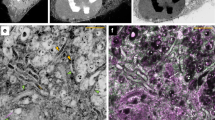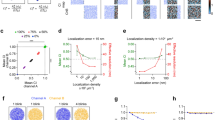Abstract
The importance of locating proteins in their context within cells has been heightened recently by the accomplishments in molecular structure and systems biology. Although light microscopy (LM) has been extensively used for mapping protein localization, many studies require the additional resolution of the electron microscope. Here we report the application of small nanocrystals (Quantum dots; QDs) to specifically and efficiently label multiple distinct endogenous proteins. QDs are both fluorescent and electron dense, facilitating their use for correlated microscopic analysis. Furthermore, QDs can be discriminated optically by their emission wavelength and physically by size, making them invaluable for multilabeling analysis. We developed pre-embedding labeling criteria using QDs that allows optimization at the light level, before continuing with electron microscopy (EM). We provide examples of double and triple immunolabeling using light, electron and correlated microscopy in rat cells and mouse tissue. We conclude that QDs aid precise high-throughput determination of protein distribution.
This is a preview of subscription content, access via your institution
Access options
Subscribe to this journal
Receive 12 print issues and online access
$259.00 per year
only $21.58 per issue
Buy this article
- Purchase on SpringerLink
- Instant access to full article PDF
Prices may be subject to local taxes which are calculated during checkout





Similar content being viewed by others
References
Anderson, K.D., Karle, E.J. & Reiner, A. A pre-embedding triple-label electron microscopic immunohistochemical method as applied to the study of multiple inputs to defined tegmental neurons. J. Histochem. Cytochem. 42, 49–56 (1994).
Nisman, R., Dellaire, G., Ren, Y., Li, R. & Bazett-Jones, D.P. Application of quantum dots as probes for correlative fluorescence, conventional, and energy-filtered transmission electron microscopy. J. Histochem. Cytochem. 52, 13–18 (2004).
Takizawa, T., Suzuki, K. & Robinson, J.M. Correlative microscopy using FluoroNanogold on ultrathin cryosections. Proof of principle. J. Histochem. Cytochem. 46, 1097–1102 (1998).
Shiao, Y.H., Resau, J.H., Nagashima, K., Anderson, L.M. & Ramakrishna, G. The von Hippel-Lindau tumor suppressor targets to mitochondria. Cancer Res. 60, 2816–2819 (2000).
Deerinck, T.J. et al. Fluorescence photooxidation with eosin: a method for high resolution immunolocalization and in situ hybridization detection for light and electron microscopy. J. Cell Biol. 126, 901–910 (1994).
Gaietta, G. et al. Multicolor and electron microscopic imaging of connexin trafficking. Science 296, 503–507 (2002).
Chan, W.C. & Nie, S. Quantum dot bioconjugates for ultrasensitive nonisotopic detection. Science 281, 2016–2018 (1998).
Michalet, X. et al. Quantum dots for live cells, in vivo imaging, and diagnostics. Science 307, 538–544 (2005).
Han, M., Gao, X., Su, J.Z. & Nie, S. Quantum dot–tagged microbeads for multiplexed optical coding of biomolecules. Nat. Biotechnol. 19, 631–635 (2001).
Chan, W.C. et al. Luminescent quantum dots for multiplexed biological detection and imaging. Curr. Opin. Biotechnol. 13, 40–46 (2002).
Voura, E.B., Jaiswal, J.K., Mattoussi, H. & Simon, S.M. Tracking metastatic tumor cell extravasation with quantum dot nanocrystals and fluorescence emission-scanning microscopy. Nat. Med. 10, 993–998 (2004).
Grecco, H.E. et al. Ensemble and single particle photophysical properties (two-photon excitation, anisotropy, FRET, lifetime, spectral conversion) of commercial quantum dots in solution and in live cells. Microsc. Res. Tech. 65, 169–179 (2004).
Liu, C., Miller, P.D., Henstrom, W.L. & Gibson, J.M. Transmission electron microscopy of semiconductor quantum dots. J. Microsc. 199, 130–140 (2000).
Herve, J.C., Bourmeyster, N. & Sarrouilhe, D. Diversity in protein-protein interactions of connexins: emerging roles. Biochim. Biophys. Acta 1662, 22–41 (2004).
Giepmans, B.N. Gap junctions and connexin-interacting proteins. Cardiovasc. Res. 62, 233–245 (2004).
Humbel, B.M., de Jong, M.D., Muller, W.H. & Verkleij, A.J. Pre-embedding immunolabeling for electron microscopy: an evaluation of permeabilization methods and markers. Microsc. Res. Tech. 42, 43–58 (1998).
Martone, M.E., Deerinck, T.J., Yamada, N., Bushong, E. & Ellisman, M.H. Correlated 3D light and electron microscopy: use of high voltage electron microscopy and electron tomography for imaging large biological structures. J. Histotechnology 23, 261–270 (2000).
Phend, K.D., Rustioni, A. & Weinberg, R.J. An osmium-free method of epon embedment that preserves both ultrastructure and antigenicity for post-embedding immunocytochemistry. J. Histochem. Cytochem. 43, 283–292 (1995).
Horisberger, M. & Vauthey, M. Labelling of colloidal gold with protein. A quantitative study using β-lactoglobulin. Histochemistry 80, 13–18 (1984).
Mansson, A. et al. In vitro sliding of actin filaments labelled with single quantum dots. Biochem. Biophys. Res. Commun. 314, 529–534 (2004).
Hanaki, K. et al. Semiconductor quantum dot/albumin complex is a long-life and highly photostable endosome marker. Biochem. Biophys. Res. Commun. 302, 496–501 (2003).
Akerman, M.E., Chan, W.C., Laakkonen, P., Bhatia, S.N. & Ruoslahti, E. Nanocrystal targeting in vivo. Proc. Natl. Acad. Sci. USA 99, 12617–12621 (2002).
Gao, X., Cui, Y., Levenson, R.M., Chung, L.W. & Nie, S. In vivo cancer targeting and imaging with semiconductor quantum dots. Nat. Biotechnol. 22, 969–976 (2004).
Jain, R.K. & Stroh, M. Zooming in and out with quantum dots. Nat. Biotechnol. 22, 959–960 (2004).
Bobik, M., Ellisman, M.H., Rudy, B. & Martone, M.E. Potassium channel subunit Kv3.2 and the water channel aquaporin-4 are selectively localized to cerebellar pinceau. Brain Res. 1026, 168–178 (2004).
Lidke, D.S. et al. Quantum dot ligands provide new insights into erbB/HER receptor-mediated signal transduction. Nat. Biotechnol. 22, 198–203 (2004).
Zhang, J., Campbell, R.E., Ting, A.Y. & Tsien, R.Y. Creating new fluorescent probes for cell biology. Nat. Rev. Mol. Cell Biol. 3, 906–918 (2002).
Tour, O., Meijer, R.M., Zacharias, D.A., Adams, S.R. & Tsien, R.Y. Genetically targeted chromophore-assisted light inactivation. Nat. Biotechnol. 21, 1505–1508 (2003).
Acknowledgements
We thank R.Y. Tsien for encouragement and support as well as H. Hakozaki for light microscopy assistance, M.E. Martone for editorial assistance, R.L. Ornberg (Quantum Dot Corporation) for providing QDs and T. Sudhof for providing the IP3R antibody. This work was supported by grants from the US National Institutes of Health to M.H.E. and R.Y. Tsien: NIH-RR04050, NIH-NS27177, NIH-1P20-GM72033.
Author information
Authors and Affiliations
Corresponding author
Ethics declarations
Competing interests
Quantum Dot Corporation (Hayward, California) supplied QD conjugates and reimbursed a meeting attendance.
Rights and permissions
About this article
Cite this article
Giepmans, B., Deerinck, T., Smarr, B. et al. Correlated light and electron microscopic imaging of multiple endogenous proteins using Quantum dots. Nat Methods 2, 743–749 (2005). https://doi.org/10.1038/nmeth791
Received:
Accepted:
Published:
Issue Date:
DOI: https://doi.org/10.1038/nmeth791



